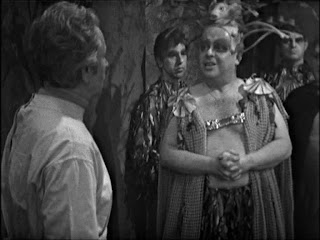The Yeti and the Intelligence are back! This adventure, a
fan favourite, is yet another six-episode story, featuring the somewhat
familiar ‘base under seige’ plotline that seems to have become very very common
at this point in Doctor Who’s history. Not that the stories don’t stand out
well individually, but it has already started to become repetitive.
 |
| A redesigned Yeti. |
For six episodes, as well, it’s always going to be a bit of
a stretch, which is why ‘Enemy of the World’ is so far my favourite story of
the fifth season. It’s different. ‘The Web of Fear’ is at its heart a strong
story though, even if it is going over old ground and ideas.
The setting of the London Underground is a very good one,
and one that the production team managed to realise very well. There’s a great
blend of characters for the story too with the return of Jack Watling as
Professor Travers, Nicholas Courtney was Colonel Alistair Lethbridge Stewart,
the strange Welsh soldier Evans played by Derek Pollitt who is terrified of
everything. Anne Travers, Professor
Travers’ daughter and scientist is well played by Tina Packer. Chorley the
reporter (Jon Rollason) and staff Sergeant Arnold (Jack Woolgar) who turns out
to be being controlled by the Intelligence are both good characters well portrayed.
Add three regulars in splendid form (even if Patrick Troughton does disappear
for all of episode two) and the ensemble is one of the best gathered for a
Doctor Who story.
 |
| Jack Watling savaged by a Yeti. |
The joy is in the shades of light and dark in each
character, mixed with moments of comedy and the twist that Arnold is the
traitor at the end which shocks everyone. Jack Watling plays Travers’ thirty
years after ‘The Abominable Snowmen’, and perhaps lays it on a bit thick, but
Anne, his daughter, balances out the ‘William Hartnell’ aspects to Travers in
‘The Web of Fear’.
It’s unclear when exactly the story is set, but we can
presume if it’s not present day (for the series at the time) it is the
near-future. There’s some lovely twists in episode six, an episode worth
finding for all those out there looking for missing Who episodes. The Doctor
this time turns the Yeti on the intelligence, but Jamie lets them loose and
destroys the Doctor’s plan to completely drain the intelligence.
 |
| Anne Travers and a Yeti |
It’s a rare story in as much as the primary goal for the
Intelligence is to capture the Doctor and consume his mind. It’s somewhat
unclear why the Intelligence has taken over the London underground system, but
it does supply a very claustrophobic atmosphere for the story. As for the web –
there’s a lot of fungussy web-like stuff throughout the story. It’s a nice idea
but at the end of the day, as a viewer you’re half expecting to see a spider or
two.
The Yeti, god bless them, have been slightly redesigned and
putting them in the underground with dim lighting does make them more menacing
than when they were out on the mountain-side and they were, dare I say, a bit
cuddly? Apparently the director, Douglas Camfield (who did a great job with
this one) spent a lot of time trying to make the Yeti sound less like a
flushing toilet! The sound does have a bit of a flushing feel to it!
At six episodes it didn’t drag as much as I feared it would,
especially as the plot is really not that complicated. The characters drive it
when not much is happening with the plot, which saves it a bit in the middle
there. Episodes two and three, rather than the later ones, are probably the
slowest for a change.
It’s not often the sequel is better than the original, but
in this case I believe it is. Comfortably. The first episode, the only one that
exists today, is very enjoyable. It has a wonderful hammer-horror feel to it
with the Yeti now in a museum of sorts run by the strange Julius
Silverstein. It would be nice to see
this one in full. It’s thoroughly enjoyable.
8.5/10



















































